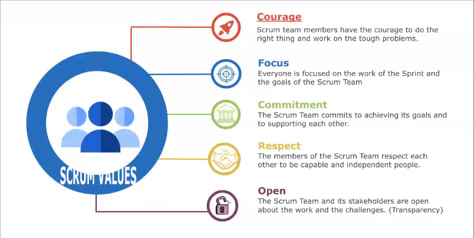SCRUM is a lightweight framework that helps people , teams and organizations generate value through adaptive solutions for complex problems. It consists of scrum team and accountabilities , scrum events, scrum values and scrum artifacts and it provides an agile way of thinking.
what is agile
agile is a method of project management used especially for software development that is characterized by the division of tasks into short phases of work and frequent reassessment and adaptation of plans based on feedback.
Contrasted with waterfall agile is a time boxed , iterative approach to software delivery that builds software incrementally from the start of the project , instead of trying to deliver it all at once near the end (waterfall).
It uses fixed-length iterations called sprints (usually 2 to 4 weeks each) to do work in bits. Based on the ancient "Divide and conquer".
The 3 Empirical Scrum Pillars
- SCRUM combines four formal events (Scrum planning, Daily Scrum , Scrum review and Scrum retrospective) for inspection and adaptation within a containing event, the sprint. These events work because they implement the empirical scrum pillars of TRANSPARENCY, INSPECTION AND ADAPTATION
SCRUM values - successful use of scrum depends on people becoming more proficient in living five values.

In scrum an iteration is called a sprint.
at the end of each sprint a deliverable is made. The sprint can be cancelled before ending only by a product owner if the sprint is judged not to be able to deliver a satisfactory increment.

PRODUCT OWNER
Responsible for maximizing the product value (ROI) of the
development effort and is accountable for the product backlog
value.Responsible for the vision of the product
Manages the product backlog (list)
(prioritize and re- prioritize)Final referee of the questions on requirement.
Accept or reject each product increment : it focuses on the
"WHAT" and not the "HOW".Decide what is released and when.
Consider the interests of stakeholders.
Has a leadership role.
DEVELOPERS(DEVELOPMENT TEAM)
Cross functional
Self-organized/self-managed, with no externally assigned roles or external influence.
Negotiate commitments with the product owner, one sprint at a time to set sprint goals based on a sprint backlog.
Has autonomy with respect to how to achieve its commitments.
Build a deliverable increment on each sprint.
Intensely collaborative.
SCRUM MASTER
Facilitates the scrum process
Causing the removal of impediments to the scrum team's progress;
Create an environment to enable self-management capture
empirical data to adjust forecasts and protects the scrum teams
from external distraction
PRODUCT BACKLOG (ARTIFACT)
This is the list of everything that is going to be done.
If it is not in the backlog it is not done.
Prioritized or ordered by the product owner (force-ranked).
Usually written in the form of a "user story".
SPRINT BACKLOG (ARTIFACT)
What you commit to do RIGHT NOW , to meet the goals of the current sprint. It is chosen from the content in the product backlog.
SPRINT TASK
Specifies how to achieve the what of GDP.
Requires approximately one day's work ,the remaining effort is
re-estimated daily, usually in hours.During sprint execution , a contact person can offer to be
primarily responsible for a task.Owned by the entire team, collaboration expected.
INCREMENT
An increment is a concrete stepping stone toward the product
goal.Each increment is additive to all prior increments and
thoroughly verified, ensuring that all increments work
together.In order to provide value , the increment must be usable by a
user.An increment cannot be considered deliverable in a sprint unless
it meets the definition of done.The definition of done is a formal description of the state of
the increment when it meets the quality measures required for
the product.The moment a product backlog items meets the definition of done,
an increment is born
SPRINT PLANNING MEETING
DAILY SCRUM MEETING
SPRINT REVIEW MEETING
RETROSPECTIVE MEETING
BACKLOG REFINEMENT
INFORMATION RADIOTOR
Information radiators are highly visible charts and figures
displaying.Project progress and status e.g. Kanban boards, burn-down
charts ,these shows the real progress and performance of the
project and team which enhances transparency and trust among
team members and other stakeholders.
USER STORIES
The stories uses non-technical language to provide context to the development team and their efforts, after you read user story the team knows why you are compiling what you are compiling and what value it creates.









Top comments (0)